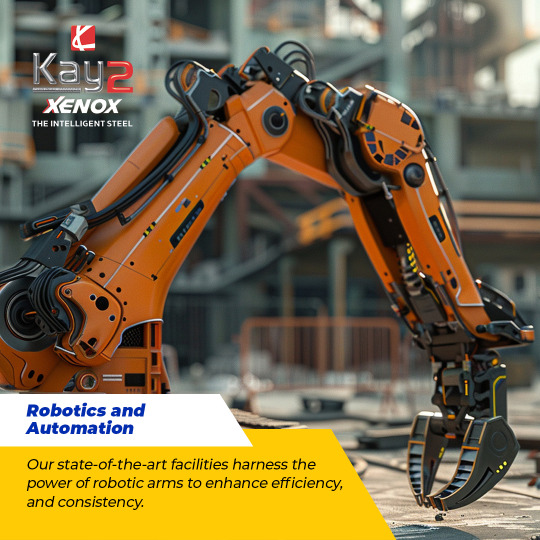#Advanced Construction Technology
Explore tagged Tumblr posts
Text







Experience the convergence of innovation and excellence with Kay2 Xenox. Together, let’s build a brighter, more sustainable tomorrow. for details visit Kay2 Blog
#Advanced Construction Technology#Innovative Steel Solutions#Hexagonal Molecular Bonding#High-Strength TMT Bars#Modern Construction Materials#Cutting-Edge Manufacturing Techniques#High-Rise Construction Safety#kay2 xenox tmt#kay2 steel
0 notes
Text
youtube
The Secrets Behind the Most Advanced Construction Technology
In this video, we will show you the world of advanced construction technology and the groundbreaking innovations The Secrets Behind the Most Advanced Construction Technology that are shaping the future of the industry. In this captivating journey, we dive into cutting-edge technologies and techniques revolutionizing the way we build and construct.
#construction vehicles#advanced construction techniques in civil engineering#advanced building construction techniques#construction methods and techniques#advanced construction techniques#construction techniques in architecture#advanced construction technology#advanced technology construction#advanced technology in construction#advanced building technology#construction tech#virtual design and construction#new construction technology#Youtube
1 note
·
View note
Text
youtube
The Secrets Behind the Most Advanced Construction Technology
In this video, we will show you the world of advanced construction technology and the groundbreaking innovations that are shaping the future of the industry. In this captivating journey, we dive into cutting-edge technologies and techniques revolutionizing the way we build and construct.
#construction vehicles#advanced construction techniques in civil engineering#advanced building construction techniques#construction methods and techniques#advanced construction techniques#construction techniques in architecture#advanced construction technology#advanced technology construction#advanced technology in construction#advanced building technology#construction tech#virtual design and construction#new construction technology#most advanced construction#Youtube
0 notes
Text

Retconned Wardi firearms- a basic handgun, a highly decorative ceremonial handgun (belonging to Faiza), and a lance-gun.
Gun tech has officially been nerfed down to hand cannons (press F) (this has been a long time coming but I'd been fallacy of sunk costs-ing myself out of retconning).
Handguns are held similarly to a shotgun, with the butt pressed into the user's shoulder, one hand gripping under the barrel, and the other free to ignite the gunpowder. These represent the most advanced firearms in contemporary usage, both in make and in their use of uniform iron projectiles built to match the gun's bore for greater range and efficiency. Lance-guns are the more basal form, usually larger and mounted with the pole held over the shoulder, and are most effectively used by two people (one to hold and aim, one to light the gunpowder).
The spread of firearms is currently mostly limited to the Eastern Inner Seaway peoples (with some additional distribution via overland trade), and actual manufacture of hand cannons and gunpowder at Significant scale is limited to the region's core powers.
The reason for this limited spread is partially due to specific elements of the technology's history. Gunpowder was first synthesized by Burri alchemists and considered to be the discovery of the legendary divine weapon + solar fire of the deity Inanariya, and its formula (along with techniques for ideally refining its components) remained a closely guarded state secret. It was used predominantly in priestly contexts to generate flame and explosive sounds (in conjunction with earlier practices of generating multicolored flames with use of other chemicals), then integrated into combustible weaponry in the forms of fire lances, which would eventually develop into early handcannons.
The treatment of gunpowder as a guarded sacred or semi-sacred substance continued with Wardi adoption, where knowledge of its making is considered a closed rite. It's name (inya tsatsul or just tsatsul, a derived adoption of the Burri iñazatsūya) still reflects a divine solar association (the Burri word means 'sun's thunder', the Wardi 'inya' invokes the sun, 'tsatsul' is an adapted loanword and has no meaning independent of the substance itself), though its priestly use is now predominantly associated with the firearm'ed Odonii (rather than priests of the solar Face Inyamache). The composition of gunpowder can no longer be regarded as a Secret by any means, though efforts to obscure the methods of its creation are still moderately successful and has kept knowledge of gunpowder manufacture more limited than the total sphere of firearm usage itself.
The actual strongest limiting factor of firearm usage is the rarity of natural saltpeter deposits necessary for making gunpowder. The practice of actively producing saltpeter via nitraries has not been developed anywhere in the setting, and all is instead obtained via natural sources. These sources are rare and limited within the current spread of firearm technology, and result in gunpowder being a limited and expensive substance to produce. The weapons themselves are also very expensive to manufacture (a good quality steel SWORD is far too material-cost prohibitive for most people to own), particularly high quality firearms designed for use with standardized ammunition.
These guns are also very basal, and logistical difficulties in their use (weight, very slow loading and firing speed, high visibility, Relatively low reach and accuracy) along with the restrictive cost of production has kept firearms far from rendering conventional weaponry, armor, and projectiles obsolete (even within the societies that have access to them). They are still, however, very devastating in use within their contemporary context, particularly in that high quality guns have a longer range than the best arrow-based projectiles, and utterly negate most contemporary forms of armor at close range.
#I'd consider the setting to be like.....most closely analogous to like 3rd-1st century BCE earth (in terms of the average scale of#societies + Most of its technology (aside from major exceptions like this) + trade interconnectivity)#There are VERY few Very Big states capable of mass-manufacturing and resource extraction (like nothing the size of#the Roman empire has Ever existed in this setting. The biggest empires aren't even close. Cynozepal has a pretty massive territorial#span so is probably the closest thing but its actual control is highly fragmented along disconnected central hubs)#There's significant seaway trade connections but the Vast majority of transmission of goods is localized (even moreso over land)#So point being firearms have developed '''''earlier''''''' than in IRL history but the conditions that enabled very rapid spread are#not really present (though it's fairly inevitable that they'll become widespread over the next few centuries)#Also the likely trajectory of adaptation is going to be the development of Plate armor (which could absorb/block shots#from some types of firearms More advanced than these).#The types of armor used in this particular region is mostly lamellar/scale/padded fabric/leather and rarely involves#full body protection (using a shield to compensate) so developing thicker and fully protective armor would be the next logical#step in the arms race#I think it would be a fun constructed history for armor technology to outpace these simple firearms enough that they end up largely#abandoned in favor of re-specializing in close combat but I don't really care to plan out the far future that much
80 notes
·
View notes
Text

I have been wondering this for such a long time (x)
#also lends more validity(?) to the idea that the planet could be#*googles if there’s a science fiction term to refer to it by*#a Dyson sphere 👀#someone else suggested that it’s post-apocalyptic Earth which had crossed my mind before as well but#with all the talk of the mother flame and going into the planet’s core to harvest the flame/power/energy - it makes one wonder…#a highly technologically advanced society would theoretically be able to construct a planet-esque dome around a star…#also calling it ‘the mother flame’ does seem to indicate it the the birth or start of something else right?#one piece#my post#bluestar#one piece volume 111#one piece theory
16 notes
·
View notes
Text
wow utterly horrifying to me that all of the petri dish alien-science children are from heterosexual couplings (with some trios thrown in the mix, notably from hyuna and/or luka, who were considered to be successes of biological engineering). crazy horrible world we live in
#which makes me think about just how far reproductive technology has advanced#idk what's more horrifying the idea that they harvested sperm and eggs from the cast or that they didn't need those to create offspring#so they're reinforceingsex and gender norms which the text explicitly acknowledges as socially constructed#sorry i'm just so horrified by those children
2 notes
·
View notes
Text
youtube
Unveiling Ancient Egypt’s Megalithic Marvels: Secrets of Advanced Engineering
The enigmatic wonders of Ancient Egypt have captivated humanity for centuries. From the towering pyramids to the mysterious Sphinx, these megalithic marvels continue to inspire awe and intrigue. Could these awe-inspiring creations be evidence of advanced ancient technology, or do they hold secrets of a lost civilization?
The Colossal Statues: Titans of Stone
Ancient Egypt’s colossal statues, such as the Great Colossi of Memnon, are feats of artistry and engineering.
Weighing hundreds of tons, these statues were carved with astonishing precision and transported across vast distances.
How could a civilization over 4,000 years ago achieve such monumental feats without modern machinery?
The Pyramids: A Symphony in Stone
The Great Pyramid of Giza is a marvel of architectural mastery, aligned with celestial bodies and featuring flawless geometry.
Some stones used in its construction weigh up to 80 tons, raising questions about ancient construction techniques.
Scholars debate whether these structures were built with rudimentary tools or advanced, forgotten technology.
Transporting Monoliths: Moving Mountains
Ancient Egyptians transported massive stone blocks from quarries to construction sites across rugged terrain.
Theories suggest the use of sledges, ramps, and water-based flotation systems, but definitive answers remain elusive.
Guardians of Eternity: The Enigma of the Sphinx
The Great Sphinx of Giza, with its weathered features and imposing presence, stands as a sentinel to the past.
Some researchers believe it may predate traditional timelines, possibly linked to the Great Flood mentioned in ancient texts.
Its precise craftsmanship and celestial alignment deepen its mystery.
Whispers of the Past: A Lost Civilization?
These remarkable structures might be the legacy of a civilization lost to history.
Evidence points to a cataclysmic event that could have wiped out advanced societies, leaving only fragments of their achievements.
Such theories challenge traditional historical narratives and invite us to rethink humanity’s origins.
Echoes of Grandeur
Ancient Egypt’s megalithic marvels continue to inspire wonder and curiosity.
Whether created through sheer determination or advanced techniques, these structures stand as timeless testaments to human ingenuity.
They remind us of the enduring quest to understand our past and connect with the brilliance of those who came before.
Exploring the mysteries of Ancient Egypt invites us to keep questioning and learning. Share your thoughts on these incredible achievements in the comments below, and join the conversation about the secrets of our shared history.
#ancient egypt#megalithic structures#egyptian pyramids#sphinx mysteries#advanced ancient technology#lost civilization#ancient engineering#great pyramid of giza#colossal statues#egyptian monuments#ancient wonders#ancient egyptian history#archeological discoveries#lost ancient technology#sphinx enigmas#pyramid construction techniques#ancient stone transport#egyptian architecture#ancient history mysteries#advanced engineering marvels#Youtube
4 notes
·
View notes
Text
pvc electric red and blue wire #smartratework#tumblr
#flowers#aesthetic#alternative#grunge#1950s#cute#japan#60s#70s#80s#|| Smart Rate Work#Manufacturing encompasses a diverse array of processes and technologies aimed at producing a wide range of products#from everyday essentials to specialized components. Take wires#for instance: these are typically manufactured through drawing processes#where metal rods or strips are pulled through dies to reduce their diameter and achieve the desired thickness. This method ensures uniformi#crucial for applications in electronics#construction#and industrial settings.#On the other hand#the production of bottles involves molding techniques such as blow molding or injection molding. Blow molding heats plastic resin into a mo#used extensively for beverage containers and packaging. Injection molding#meanwhile#injects molten plastic into a mold under high pressure#ideal for producing intricate shapes with precision#like medical vials or automotive parts.#Both wire and bottle manufacturing rely heavily on materials science#engineering precision#and quality control measures to meet stringent specifications. Advances in automation#robotics#and sustainability practices are transforming these industries
2 notes
·
View notes
Text



#space#futuristic#architecture#ships#dystopian#industrial#cityscape#technology#structures#spacecraft#buildings#clouds#sci-fi city#spaceship fleet#towering skyscrapers#celestial body#colossal structures#advanced civilization#dark atmospheric sci-fi#high-tech urban landscape#multi-level space city#deep space exploration#starship construction site#alien metropolis skyline#ai#ai generated#ai generated images#ai generated tags
2 notes
·
View notes
Text
The Backbone of Construction: A Deep Dive into Construction Equipment
When you pass by a construction site, what catches your eye? It’s not just the towering structures or the bustling workers; it’s the array of heavy machinery and equipment that makes the entire process possible. Construction equipment serves as the backbone of any construction project, enabling the realization of architectural marvels and infrastructural development. In this article, we will take…

View On WordPress
#advanced construction equipment#bulldozers#Construction Equipment#construction equipment automation#construction equipment evolution#construction equipment future#construction equipment safety#construction equipment significance#construction equipment trends#construction equipment types#construction industry#construction machinery#construction site equipment#Construction Technology#construction tools#construction vehicles#cranes#earthmoving equipment#environmental impact#equipment for construction#equipment types#excavators#heavy machinery#material handling equipment#precision machinery#Sustainable Construction
3 notes
·
View notes
Text
Smart Building Technologies: AI & IoT Solutions for Modern Construction
Explore how smart building technologies are revolutionizing the construction industry in Philadelphia. With AI in construction management and IoT in building automation, companies are enhancing efficiency, safety, and sustainability in every phase of a project. Discover how AI-driven construction safety solutions are helping to prevent accidents and improve decision-making on-site. From high-rise developments to smart infrastructure, these innovations are shaping the future of urban building. Learn how adopting smart building technologies can future-proof your projects and ensure compliance with modern standards in one of America's most competitive construction markets.
#smart building technologies in Philadelphia construction#AI in construction management in Philadelphia#IoT in building automation systems Philadelphia#AI-driven construction safety tools in Philadelphia#Philadelphia smart construction technologies#advanced IoT solutions for building automation Philadelphia#artificial intelligence in Philadelphia building projects#construction safety technology for Philadelphia contractors#smart infrastructure development in Philadelphia#energy-efficient smart buildings using AI and IoT Philadelphia
0 notes
Text
Schneider Capacitor MEHVCGSF224A48
Upgrade your AEC switchgear with the Schneider Capacitor MEHVCGSF224A48 for improved performance and reliability. This high-quality capacitor is designed to enhance the efficiency of your electrical system, allowing for smoother operation and reduced energy consumption. With its durable construction and advanced technology, this Schneider Capacitor is a must-have for any industrial or commercial setting. Trust Schneider Electric to deliver top-of-the-line products for all your electrical needs.
#electrical equipment#electrical#switchgear#electrical supplier#electrical supplies#capacitors#capacitor#business#industrial#Upgrade your AEC switchgear with the Schneider Capacitor MEHVCGSF224A48 for improved performance and reliability. This high-quality capacit#allowing for smoother operation and reduced energy consumption. With its durable construction and advanced technology#this Schneider Capacitor is a must-have for any industrial or commercial setting. Trust Schneider Electric to deliver top-of-the-line produ
0 notes
Text
Brazil, UAE, and Indonesia: The New Frontiers for Gas Welding Outfits Market Players
Brazil, UAE, and Indonesia are emerging as the fastest-growing demand hubs within the $862.5 million Gas Welding Outfits market. These markets are expected to experience a Compound Annual Growth Rate (CAGR) ranging from 3.9% to 5.8% between 2025 and 2030. The automotive manufacturing and construction & infrastructure sectors are key application areas for gas welding outfits, and competition in these sectors is intensifying.
Check detailed insights here - https://datastringconsulting.com/industry-analysis/gas-welding-outfits-market-research-report
The construction and infrastructure industries particularly rely on gas welding outfits for fabricating, joining, and repairing metal structures. Outfits equipped with oxy-acetylene twin hoses are widely used in these industries due to their high heat output, which ensures the creation of strong and durable joints. Leading construction firms like Bechtel Corporation and Vinci leverage these advanced welding outfits to maintain high standards for resilient and enduring structures.
Market Players Driving Innovation
Leading players such as Miller Electric, Lincoln Electric, ESAB, Fronius International, Colfax Corporation, Hobart Welding Products, Panasonic Welding Systems, Illinois Tool Works, GCE Group, Messer Cutting Systems, Arcon Welding Equipment, and Shenzhen Riland Industry are at the forefront of innovation. These players are continuously forging strategic partnerships and pushing the boundaries of technology to capture larger market shares and offer enhanced welding solutions.
For further insights, check out the detailed report here.
Technological Advancements in Gas Welding Outfits
Technological innovations have dramatically transformed the gas welding outfits industry. The introduction of advanced technologies, such as laser welding outfits, has improved the efficiency and accuracy of welding operations. This has provided substantial opportunities for manufacturers to enhance their output and quality standards. Modern gas welding outfits now support more complex fabrications and repair tasks that were previously considered impossible, marking the industry's shift towards greater sophistication and competency.
Global & Regional Market Analysis
The Gas Welding Outfits market is expected to rise to $1.637 billion by 2035, up from $862.5 million in 2024, with a CAGR of 6.0%. The North American market exhibits a strong presence due to the expanding construction and automobile sectors in the region. The market is also supported by a focus on safety regulations, which has led to an increased demand for gas welding outfits that meet stringent quality and safety standards. Key players such as Lincoln Electric and Illinois Tool Works are reshaping the competitive landscape by investing heavily in research and development to create innovative and energy-efficient products. Additionally, exploration and extraction activities in the oil and gas sector are expected to further drive demand for these outfits.
Research Scope
Segment:
Product Type: Oxy-Fuel, TIG Welding, MIG Welding
Application: Industrial Use, Personal Use, Educational Institutions, Others
Technology: Electric Powered, Fuel Powered
Distribution Channels: Online Retail, In-store Retail
End-User Industry: Automotive, Construction, Energy, Manufacturing & Fabrication Units, Others
About DataString Consulting
DataString Consulting helps businesses craft effective strategies, including Total Addressable Market (TAM) expansion, revenue diversification, and market entry approaches. By offering in-depth insights into emerging trends, competitor landscapes, and customer demographics, DataString Consulting provides tailored strategies that filter out industry noise and open up new opportunities.
As a professional market research company, DataString Consulting offers a comprehensive range of market and business research solutions under one roof. With a team that combines over 30 years of experience in market and business research, the firm provides precise solutions for businesses seeking to optimize their strategies and tap into high-growth sectors.
#Gas Welding Outfits Market#Welding Equipment#Gas Welding#Market Research#Industry Growth#Gas Welding Market Analysis#Welding Outfits#Market Forecast#Automation in Manufacturing#Welding Industry Trends#Revenue Expansion Opportunities#Welding Technology Innovations#Gas Welding Demand#Market Expansion#Strategic Partnerships#North America Welding Market#Europe Welding Market#Emerging Markets#Brazil UAE Indonesia Welding Market#Welding Applications#Automotive Welding#Metal Fabrication#Pipeline Construction Welding#Aircraft Maintenance Welding#Welding Safety#Technological Advancements in Welding
0 notes
Text
youtube
The Secrets Behind the Most Advanced Construction Technology
In this video, we will show you the world of advanced construction technology and the groundbreaking innovations that are shaping the future of the industry. In this captivating journey, we dive into cutting-edge technologies and techniques revolutionizing the way we build and construct.
#construction vehicles#advanced construction techniques in civil engineering#advanced building construction techniques#construction methods and techniques#advanced construction techniques#construction techniques in architecture#advanced construction technology#advanced technology construction#advanced technology in construction#advanced building technology#construction tech#virtual design and construction#new construction technology#most advanced construction#Youtube
0 notes
Text
Built for Complexity | How Industrial Estimating Service Handles Custom Manufacturing Projects
Introduction: The Complexity of Custom Manufacturing Projects Custom manufacturing projects are often among the most challenging in the industrial construction sector. Unlike standard builds, these projects involve unique designs, specialized materials, and processes that may not be readily available in off-the-shelf cost databases. Each project brings its own set of variables—often with tight schedules and high demands for precision. This is where industrial estimating services come into play, providing the expertise and tools needed to deliver accurate cost forecasts, no matter how complex the project.
Understanding the Challenges of Custom Manufacturing Custom manufacturing projects typically involve the construction of facilities or systems tailored to specific needs, such as custom machinery, production lines, or specialized storage systems. These projects don’t always fit neatly into predefined categories, which makes estimating their costs particularly tricky. The lack of readily available benchmarks for labor, materials, and equipment means estimators must dig deeper to gather accurate data, assess unique risks, and account for variability in the construction process.
The Role of Industrial Estimating Service in Custom Projects Industrial estimating services play a critical role in ensuring that custom manufacturing projects are properly scoped, budgeted, and executed. Estimators rely on a combination of historical data, industry expertise, and sophisticated estimating tools to account for the unique requirements of each project. They assess design drawings, review material specifications, and factor in the intricacies of the production process to arrive at cost estimates that reflect the project’s true scope and complexity.
Detailed Scope Analysis and Custom Material Costs Custom manufacturing projects often require specialized materials that may not have standard pricing available in cost databases. Estimators take the time to analyze material specifications, identify alternative options, and gather quotes from suppliers to ensure that the cost of materials is accurately reflected in the estimate. They may also assess the long-term costs of certain materials, such as maintenance requirements or supply chain challenges, to provide a more comprehensive financial outlook.
Handling Non-Standard Labor Requirements One of the most significant challenges in custom manufacturing projects is managing labor costs. These projects often require skilled labor or specialized subcontractors with expertise in custom processes or equipment. Industrial estimating services evaluate the labor market, assess wage rates for specific skill sets, and account for the potential need for overtime or specialized training. This ensures that the labor component of the estimate is both realistic and aligned with project requirements.
Accounting for Unique Equipment and Tools Custom projects frequently involve unique or specialized equipment, from advanced machinery to custom-designed tools and fixtures. Estimating these costs is far more complex than simply applying standard equipment rental rates. Estimators must account for the cost of acquiring, maintaining, or leasing such equipment, as well as any potential downtime associated with custom tools. In some cases, they may need to work with equipment manufacturers to determine accurate pricing or cost projections for these items.
Risk Assessment and Contingency Planning The nature of custom manufacturing projects often leads to unforeseen challenges—whether it’s unexpected site conditions, delays in material delivery, or the need for rework due to design changes. Industrial estimating services help mitigate these risks by incorporating contingency allowances into their estimates. They conduct a thorough risk assessment to identify potential challenges that could impact the project’s timeline and budget. By factoring in these uncertainties, they provide a more reliable financial forecast, which helps stakeholders make informed decisions about project feasibility and budgeting.
Timeline Sensitivity and Cost Efficiency In custom manufacturing projects, timelines are often tight, and any delays can significantly impact overall costs. Industrial estimating services evaluate the project schedule in relation to the scope and complexity of the work, considering factors like lead times for custom materials, labor availability, and equipment procurement. They incorporate these time-sensitive factors into their estimates, ensuring that the project is planned efficiently from a cost perspective. By optimizing the timeline and identifying opportunities to streamline construction, estimators help reduce costs and keep the project on track.
Integration of Technology for Enhanced Accuracy To handle the complexities of custom manufacturing projects, industrial estimating services increasingly rely on advanced technology. Software tools and Building Information Modeling (BIM) platforms allow estimators to visualize the project in greater detail, integrate different design elements, and identify potential cost-saving opportunities. These tools provide a more accurate picture of the project’s scope, helping estimators refine their forecasts and catch potential issues before construction begins. Additionally, digital tools can analyze historical project data to inform more accurate pricing for custom materials and processes.
The Importance of Communication Between Stakeholders A successful custom manufacturing project requires coordination between various stakeholders, including the design team, contractors, suppliers, and equipment manufacturers. Industrial estimating services ensure that all parties are aligned by providing clear, detailed cost breakdowns and communicating any uncertainties or risks associated with the estimate. This transparency helps prevent misunderstandings and ensures that all stakeholders have a clear understanding of the budget and timeline.
Providing Value Engineering Alternatives In custom manufacturing, budget constraints are common, and finding ways to reduce costs without compromising quality is crucial. Industrial estimating services often work closely with the design team to identify value engineering alternatives that can reduce costs. These might include suggesting alternative materials, adjusting the scope of certain features, or proposing changes to construction methods that maintain the integrity of the design while offering cost savings. This value-driven approach helps ensure that custom manufacturing projects are both financially viable and high-quality.
Conclusion: Precision and Flexibility for Custom Manufacturing Success Custom manufacturing projects present unique challenges, but industrial estimating services are equipped to handle the complexity. By leveraging specialized knowledge, advanced technology, and real-time data, estimators ensure that these projects are properly budgeted, efficiently executed, and financially viable. Whether it’s managing specialized materials, labor, equipment, or risk, industrial estimating services help turn custom manufacturing challenges into opportunities for success.
#custom manufacturing#industrial estimating#complex project estimating#specialized materials#labor cost estimating#equipment cost estimation#risk assessment#construction contingencies#value engineering#manufacturing plant construction#cost forecasting#project budgeting#skilled labor estimating#custom equipment pricing#contingency planning#project timeline#advanced estimating tools#BIM in estimating#project risk management#estimating software#project scope analysis#construction site conditions#custom tool costs#lead time management#cost-saving alternatives#subcontractor pricing#custom project forecasting#construction project efficiency#estimating technology#manufacturing process planning
0 notes
Text
The Competitive Landscape of the Global Self-Healing Coatings Market

Self-Healing Coatings Market Introduction:
The Self-Healing Coatings market is predicted to develop at a compound annual growth rate (CAGR) of 34.3% from 2024 to 2034, when it is projected to reach USD 16,586.69 Million in 2034, based on an average growth pattern. The market is estimated to reach a value of USD 2,783.74 Million in 2024.
Self-healing coatings are innovative materials designed to autonomously repair minor damages, such as scratches and cracks. These coatings incorporate microcapsules or other smart materials that release healing agents when the surface is compromised, initiating a repair process. This technology extends product lifespan, reduces maintenance costs, and enhances durability. The market for self-healing coatings is rapidly expanding due to increasing demand across industries like automotive, aerospace, construction, and electronics.
Get a sample copy of this report:https://wemarketresearch.com/reports/request-free-sample-pdf/self-healing-coatings-market/1556
Self-Healing Coatings Market Drivers
Several factors are driving the growth of the self-healing coatings market:
Increased Demand for Durability and Longevity: Industries are constantly seeking ways to enhance the durability and lifespan of their products. Self-healing coatings offer a solution by extending the service life of materials, reducing maintenance costs, and improving reliability.
Advancements in Materials Science: Ongoing research and development in materials science have led to more effective and affordable self-healing technologies. This has made it possible to integrate these coatings into a broader range of applications.
Environmental Concerns: As industries strive for more sustainable practices, self-healing coatings offer an eco-friendly solution by reducing the need for frequent replacements and repairs, which in turn lowers waste and resource consumption.
Automotive and Aerospace Industries: These sectors are major adopters of self-healing coatings due to their high performance and safety requirements. Self-healing coatings can significantly enhance the durability of parts exposed to harsh conditions.
Applications and Benefits
The potential applications of self-healing coatings are extensive:
Automotive Industry: Self-healing coatings can be applied to car exteriors to repair minor scratches and maintain a pristine appearance. This reduces the need for costly repainting and repairs.
Aerospace Sector: In aerospace, self-healing coatings can protect aircraft components from damage caused by environmental factors and operational stresses, enhancing safety and reducing maintenance costs.
Electronics: Self-healing coatings can be used to protect sensitive electronic components from damage and wear, thereby extending the life of electronic devices.
Infrastructure: Buildings and bridges coated with self-healing materials can experience fewer issues related to wear and tear, leading to reduced maintenance costs and longer lifespans.
Companies Covered:
Akzo Nobel N.V.
BASF SE
Dow Chemical Company
PPG Industries
3M Company
Sherwin-Williams Company
Axalta Coating Systems
Nippon Paint Holdings Co., Ltd.
Jotun Group
Hempel A/S
Advanced Polymer Coatings
Nissan Chemical Industries, Ltd.
Cortec Corporation
Autonomic Materials, Inc.
Sika AG
Market Segments
By Material Type
Polymers
Ceramics
Metal
Others
By Formulation Type
Intrinsic Self-Healing
Extrinsic Self-Healing
By End-use
Automotive
Construction
Aerospace
Electronics
Marine
Others
Growth Factors Driving the Self-Healing Coatings Market
The self-healing coatings market is experiencing robust growth, propelled by several key factors. Understanding these growth drivers provides valuable insight into why this technology is becoming increasingly prominent across various industries. Here’s an in-depth look at the primary factors contributing to the expansion of the self-healing coatings market:
Increasing Demand for Durability and Longevity
In an era where the durability of products is highly valued, self-healing coatings offer a compelling solution. These coatings can significantly enhance the lifespan of materials by repairing minor damages autonomously, which reduces the frequency of repairs and replacements. Industries ranging from automotive and aerospace to construction are seeking ways to extend the service life of their components, driving demand for self-healing technologies.
Technological Advancements in Materials Science
The self-healing coatings market is benefiting from ongoing advancements in materials science. Innovations such as the development of more effective microcapsules, advanced vascular systems, and reversible chemical mechanisms have improved the efficiency and applicability of self-healing coatings. Research and development efforts continue to refine these technologies, making them more versatile and cost-effective.
Future Prospects
The future of the self-healing coatings market looks promising. Ongoing advancements in nanotechnology, biomimetic design, and material science are expected to lead to even more innovative and effective self-healing solutions. Additionally, as industries continue to focus on sustainability and efficiency, the demand for self-healing coatings is likely to grow.
Key objectives of this research are:
To explore Global Market size by respective indicators.
To scrutinize the sum and estimation of the Global Self-Healing Coatings Market Market, Based on key aspects.
To offer an account of the competitive landscape and investigate their development plans.
To examine the Global Market for growth possibilities, and strategic growth.
To review the Global Market size (volume and worth) from the organization, key market regions, items and applications, and statistical data.
To generate competitive learnings and factors analysis, SWOT examination, and business improvement plans for the future.
To scrutinize the range of available and novel organic business growth strategies.
Conclusion
Self-healing coatings represent a groundbreaking advancement in material science, offering the promise of enhanced durability, reduced maintenance, and improved sustainability. As the technology continues to evolve, we can expect to see a broader adoption of these coatings across various sectors, ultimately leading to more resilient and long-lasting products. Whether in the automotive, aerospace, electronics, or infrastructure industries, the self-healing coatings market is set to make a significant impact in the years to come.
Contact Us:
Mr. Robbin Joseph
Corporate Sales, USA
We Market Research
USA: +1-724-618-3925
Websites: https://wemarketresearch.com/
Email: [email protected]
#Advanced Materials#Surface Protection#Nanotechnology#Polymer Science#Smart Materials#Coating Technology#Market Trends#Sustainable Coatings#Automotive Coatings#Aerospace Coatings#Construction Materials#Smart Surface Materials
0 notes